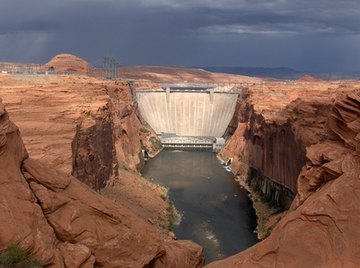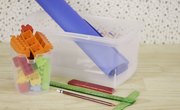
Imagine flying over a landform in a low-flying plane. You look down at an oxbow lake and say to yourself "Oh, I can see so clearly the river's meandering path and the cutoff point that created the oxbow." Geography comes alive. Making a working model brings the same excitement to the study of geography, and can help students visualize how water pressure releases from dams. Thermocol (styrofoam) is an easy material to work with in order to create a working model of a dam.
- small square aluminum pan
- 2 boxes reusable modeling clay, preferably oil based
- ruler
- small thermocol sheet available at any craft store
- knife
- large nail
- permanent marker
You can landscape the river banks with spray paint and small plastic trees for increased realism.
Fill the pan with modeling clay up to half an inch from the top. Make score lines lengthwise, dividing the pan into thirds. Scoop out and put aside the clay from the center third leaving just a thin layer on the bottom of the pan. This layer will help to hold the thermocol dam in place. You now have a model of a land form through which a river will flow. The two side walls are the river banks. You will fill the scooped out center with water in imitation of a river.
Measure the height of the banks and the distance between the two banks. Lay the thermocol sheet on the table. With the marker draw the dimensions onto the sheet. Lightly score along the lines. Cut out the piece, using an ordinary box cutter or a serrated knife (the kind used to carve Halloween pumpkins). Wedge it between the banks. Check for a tight fit. If the piece seems larger than the opening between the two walls then use a ruler to scrape away the clay walls a little at a time, until the thermocol dam fits. If the piece is small and you can see space on the sides where the river water would trickle through, then take the modeling clay you had set aside. Add a little bit to the wall (either side) and try the wedge again. You may need to repeat this a few times to ensure a tight fit.
Remove the thermocol wedge. Lay it on a table. With the marker mark three circles along the length, so that when you put the dam back on the river bed the holes line up vertically, not horizontally. Think of three buttons on a shirt, going from top to bottom. Use the nail in a slow back-and-forth motion to punch out holes on the marked circles.
Take some of the clay that you had put aside and roll into a tube. Insert into the hole of the thermocol dam to for a tight fitting cork. You may have to roll the tube in different thickness to find the size that will be a watertight plug. Hold the dam steady with one hand and cut off the excess length of cork with the box cutter or ruler. Cut two more plugs from the tube length. Place plugs in the holes. Replace the thermocol dam on the riverbed about half way down the pan.
Slowly fill the river by pouring water in the riverbed on one side of the dam. The water will lap the dam wall, unable to go through to the other side.
Tell the students you will remove the plugs one at a time. Before you take out the plugs ask the students to guess which stream will land the farthest. Give the marker to a student. Ask her to mark the point where the water lands. Remove the topmost plug first. Mark the landing point on the side wall. Repeat with the center plug, and finally the lowest plug. The pressure of the water column causes the lowest stream to travel the farthest.
Things You'll Need
Tips
References
Tips
- You can landscape the river banks with spray paint and small plastic trees for increased realism.
About the Author
Anjali Amit is a children's book author with two published books. She has a master's degree in English literature. Amit has worn many hats including banker, tax accountant, writer, bookkeeper and teacher. She has been published in "Highlights," "Kite Tales," "Viatouch," "Stories for Children," "Fandangle" and "Imagination Cafe."
Photo Credits
Glen Canyon Dam image by TurboJJJ from Fotolia.com
